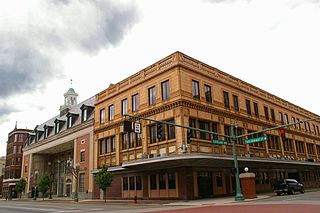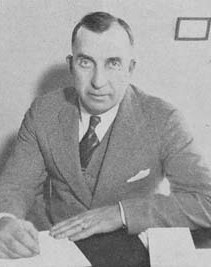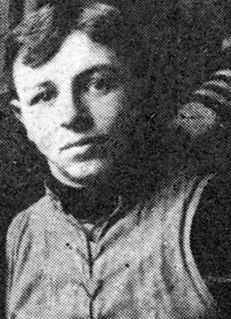
Canton is a city in and the county seat of Stark County, Ohio, United States. It is located approximately 60 miles (97 km) south of Cleveland and 20 miles (32 km) south of Akron in Northeast Ohio. The city lies on the edge of Ohio's extensive Amish country, particularly in Holmes and Wayne counties to the city's west and southwest. Canton is the largest municipality in the Canton-Massillon, OH Metropolitan Statistical Area, which includes all of Stark and Carroll counties. As of the 2010 Census, the population was 73,007, making Canton eighth among Ohio cities in population.
The Akron Pros were a professional football team that played in Akron, Ohio, from 1908 to 1926. The team originated in 1908 as a semi-pro team named the Akron Indians, but later became Akron Pros in 1920 as the team set out to become a charter member of the American Professional Football Association. Fritz Pollard, the first black head coach in the NFL, co-coached the Akron Pros in 1921. Paul Robeson played for the team in 1921 as well. He was among the earliest stars of professional football, before football became segregated from 1934 to 1946. In 1926, the name was changed back to the Akron Indians, after the earlier semi-pro team. Due to financial problems, the team suspended operations in 1927 and surrendered its franchise the following year.
The Cleveland Tigers were the first Cleveland team franchise in what became the National Football League (NFL). The Tigers played in the "Ohio League" before joining the American Professional Football Association during the 1920 and 1921 seasons.
The 1920 APFA season was the inaugural season of the American Professional Football Association, renamed the National Football League in 1922. The league was formed on August 20, 1920, by independent professional American football teams from Ohio, all of whom had previously played in the Ohio League or New York Pro Football League (NYPFL). At the meeting, they first called their new league the American Professional Football Conference. A second organizational meeting was held in Canton on September 17, adding more teams to the league, and at the meeting, the name of the league became the American Professional Football Association. Four other teams also joined the Association during the year. Meanwhile, Jim Thorpe of the Canton Bulldogs was named the APFA's first president but continued to play for the team.

Samuel Stienneck Willaman was an American football player and coach. He served as the head coach at Iowa State University (1922–1925), Ohio State University (1929–1933), and Western Reserve University (1934), compiling a career college football record of 47–26–9. At Iowa State, Willaman integrated the team by playing Jack Trice.

Alfred Louis Nesser was a professional American football offensive lineman. He played for seven teams: Akron Pros, Cleveland Bulldogs, Columbus Panhandles, Akron Indians, New York Giants, and Cleveland Indians in the National Football League (NFL) and the Cleveland Panthers in the first American Football League. He won NFL Championship titles with the Akron Pros in 1920 and the New York Giants in 1927. During his career, Nesser played against Charlie Copley, Fritz Pollard and Jim Thorpe.
Homer Hurd Davidson was a professional Major League Baseball player for the Cleveland Naps. Born in Cleveland, Ohio, he played only 6 games for the Naps during the 1908 season. Davidson was better known as a professional football player. He played in the Ohio League, which was the direct predecessor to the modern National Football League. One veteran Ohio sportswriter once rated Davidson to be the equal of Walter Eckersall, an infamous quarterback from the University of Chicago. He attended college at the University of Pennsylvania and played on the Penn Quakers baseball team.
The Canton Bulldogs–Massillon Tigers betting scandal was the first major scandal in professional football in the United States. It refers to a series of allegations made by a Massillon, Ohio newspaper charging the Canton Bulldogs coach, Blondy Wallace, and Massillon Tigers end, Walter East, of conspiring to fix a two-game series between the two clubs. One account of the scandal called for Canton to win the first game and Massillon was to win the second, forcing a third game—with the biggest gate—to be played legitimately, with the 1906 Ohio League championship at stake. Another account accused Wallace and East of bribing Massillon players to throw a game in the series. Canton denied the charges, maintaining that Massillon only wanted to damage the club's reputation. Although Massillon could not prove that Canton had indeed thrown the second game and it remains unknown if there was ever a match-fixing agreement, the scandal tarnished the Bulldogs name and reportedly helped ruin professional football in Ohio until the mid-1910s.
The Massillon Tigers were an early professional football team from Massillon, Ohio. Playing in the "Ohio League", the team was a rival to the pre-National Football League version of the Canton Bulldogs. The Tigers won Ohio League championships in 1903, 1904, 1905, and 1906, then merged to become "All-Massillons" to win another title in 1907. The team returned as the Tigers in 1915 but, with the reemergence of the Bulldogs, only won one more Ohio League title. Pro football was popularized in Ohio when the amateur Massillon Tigers, hired four Pittsburgh pros to play in the season-ending game against Akron. At the same time, pro football declined in the Pittsburgh area, and the emphasis on the pro game moved west from Pennsylvania to Ohio.

The Shelby Blues were an American football team based in Shelby, Ohio. The team played in the Ohio League from 1900 to 1919. In 1920, when the Ohio League became the APFA, the Blues did not join but continued to play against APFA teams, only to later suspend operations. The Blues returned to play as an independent between 1926 and 1928.

Pedro "Pete" Calac was a professional football player who played in the Ohio League and during the early years of the National Football League. Over the course of his 10-year career he played for the Canton Bulldogs, Cleveland Indians, Washington Senators, Oorang Indians and the Buffalo Bisons.
Ralph George "Fat" Waldsmith was a professional football player during the early years of the National Football League. Waldsmith won an NFL championship with the Canton Bulldogs in 1922. before that season, he played for the Cleveland Indians in the American Professional Football Association, which was the run-up to the NFL.
Harry Turner was a professional football player. He was one of the most popular players on the Canton Professionals, the pre-National Football League version of the Canton Bulldogs who played in the Ohio League. The team's center, Turner played with the Pros from around 1911 until his death in 1914.

George Watson "Peggy" Parratt was a professional football player who played in the "Ohio League" prior to it becoming a part of the National Football League. Born in Cleveland, Ohio, Parratt played for quarterback for the Shelby Blues, Lorain Pros, Massillon Tigers, Massillon All-Stars, Franklin Athletic Club of Cleveland, Akron Indians and the Cleveland Tigers between 1905 and 1916. Parratt threw the first legal forward pass in professional football history while playing for the Massillon Tigers on October 25, 1906.
Alvah (Alva) Andrew "Doc" Young was a founder of the National Football League. He was also the owner of NFL's Hammond Pros from 1920 until 1926. He was also a respected medical doctor and sports trainer.

Arthur Fobare Ranney was a co-founder of the American Professional Football Association, as an owner of the Akron Pros, one of the league's charter teams. The Pros were renamed the Akron Indians in 1926.
The Akron East Ends are a defunct amateur American Football team that played in the Ohio League, a forerunner to the National Football League. They played in Akron, Ohio, from 1894 until at least 1904. Its primary rivals were the amateur Canton Athletic Association, the Shelby Blues, and later the Massillon Tigers. The team became known as the Akron Athletic Club around 1904.
The Coleman Athletic Club of Akron was a professional American football team based in Akron, Ohio in 1913. The team played in the Ohio League and was formed when C.P. Parker, secretary of the baseball's Akron Giants, of the Interstate League, formed a new Akron-based football team to compete with Peggy Parratt and his Indians. Parker first convinced a few of Parratt's regulars to sign with his club. He then loaded the rest of roster with ex-players from the Elyria Athletics, which had just folded a week prior.
The Canton Bulldogs were a professional American football team, based in Canton, Ohio. They played in the Ohio League from 1903 to 1906 and 1911 to 1919, and the American Professional Football Association, from 1920 to 1923 and again from 1925 to 1926. The Bulldogs would go on to win the 1916, 1917 and 1919 Ohio League championships. They were the NFL champions in 1922 and 1923. In 1921–1923, the Bulldogs played 25 straight games without a defeat, which as of 2018 remains an NFL record. As a result of the Bulldogs' early success along with the league being founded in the city, the Pro Football Hall of Fame is located in Canton. Jim Thorpe, the Olympian and renowned all-around athlete, was Canton's most-recognized player in the pre-NFL era.










